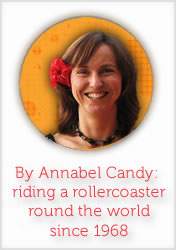3 Unmissable Storytelling Tips to Captivate Your Readers

Guest post by Hari Kotrotsios
“Can you make up a story?” my friend’s kids asked me many years ago.
“Oh, okay, how about: the three bears were walking through the forest when…”
“Can we go and play?”
“But I’m telling you a story.”
“That’s boring!”
The kids didn’t want a dry narrative. They wanted vibrant action and a wild imagination. They wanted to see, hear, smell and feel the story. So do adults, whether they’re reading a blog or listening to a presentation.
As a newspaper journalist my writing was black and white – and apparently, so was my storytelling. Every week I was challenged to come up with a new chapter, wild characters and incredible plots. Our story became interactive and the kids helped define the characters and events.
While the verbal storytelling improved my presentation techniques, my newly-developed imagination also affected my writing style:
- I incorporated imagery.
- I added dialogue.
- I simplified the narrative.
- I added more action.
Make storytelling personal
Darren LaCroix, the 2001 World Champion of Public Speaking, says we use stories to make our point (or lessons) more memorable. People learn from stories, which are more powerful than statistics, lists or graphs.
- When your stories show what you have experienced, learned or achieved, the reader can discover the point/lesson for themselves.
- Sharing your experiences allows the reader to connect with you, and they can make their own judgment or informed choice about an issue or idea.
3 storytelling mistakes and tips on how to avoid making them
- Wordiness/repetition. Long-winded descriptions and minute details are not necessary. Be specific.
- Stating the obvious. Let your story tell the message. The reader can usually figure it out themselves. Give them an “ah-ha” moment.
- Reader participation. When you tell a story in narrative format, it doesn’t involve the reader. It’s like speaking at them. They want to see the action, hear the dialogue, and feel the emotions.
Telling: Dinner was a failure.
Showing: I shifted my gaze from the stained cutlery strewn across the bench top to the red liquid oozing out of the blackened pot. A pungent, smoky aroma hovered in the kitchen. “I’ll go order pizza,” John grinned, walking out of the kitchen.
3 storytelling tips which show what you mean
Storytelling Tip 1
Use active voice. Active voice conveys a stronger sense of action and is a more direct way of storytelling. It helps keep the action fresh and fast-paced.
Passive: Too many repetitive words should not be used in a sentence.
Active: Don’t use too many repetitive words in a sentence.
Storytelling Tip 2
Use word pictures. Add details to describe a scene. For example, when talking about your favourite place to someone who’s never been there, you’ll want to bring out the colours, smells and sounds.
Telling: There was thunder outside.
Showing: Thunder roared like a freight train.
Storytelling Tip 3
Describe emotions. How do you know when someone is angry/sad/tired/bored? You can show this by describing their facial and body expressions, or by the sound of their voice.
Telling: She cried.
Showing: She bit her lip as her eyes welled with tears. She blinked furiously but couldn’t stop the tears streaming down her face.
Describing actions and emotions allows the reader to experience them too. By engaging their senses, you draw the reader into the story and take them on a journey which entertains, educates, motivates or inspires them.
“What chapter are we up to now?’ the kids asked as we snuggled in bed three years later.
“I think it’s chapter 43.”
“Lucky mum and dad have gone out tonight,” they giggled, “We can be as loud as we want and won’t get into trouble!”
Which stories captivate you? Got more storytelling tips to share?
Hari Kotrotsios is a writer and journalist, based in Coolum Beach, Queensland, Australia. She can be contacted via her blog The Goldilocks Trilogy.









Thanks Hari for this post.
Love the points you make, but, even more importantly, the examples you give. So many tell us what we should do but don’t show us how – thank you.
And thanks Anabel for introducing us to Hari.
Desolie | sharpens your writing
Hi Desolie, yes, Hari walks the walk doesn’t she?! Great to see your smiley face here again:)
Forgot to say thank you Hari for sharing your storytelling tips with us:)
Great article. This is something I still struggle with. I keep forgetting that the one hearing my story doesn’t see what’s in my head. I have to show them!
Hi Steve, me too! Or I go to the opposite extreme and bash them over the head with it. Still, it’s like anything else – practice, practice, practice:)
Thanks for your feedback, Desolie.
It is a challenge for most of us, but can be refined through lots of writing practice! I generally start writing in narrative form to get the basic outline, then rework areas to make them “show” more than “tell”.
I loved this on many levels. I have learned over time that if the reader can engage their senses in the story, see, smell, taste, feel, hear, they become immersed in the story. I try to remember what I love about my favorite books and replicate that feeling as much as possible.
Great advice and examples.
Thanks!
b
That point about active not passive is the one I need to remember, it makes such a difference. And it’s so true that reading your examples is what makes the points stick, a great example of show don’t tell. I use lots of personal quotes and stories in my (factual) books to emotionally connect with the reader in a way that straight text with facts and figures just can’t.
I just retired from teaching in a graduate school. Students have told me over the years that what they remember from my class is the stories! This is great advice. I especially like the ruined dinner example. Thank you for the great tips.
Great post. I’d like to share a fabulous website for writers called:
http://thebookshelfmuse.blogspot.com/
They have an emotional thesaurus, which is amazing to show, versus tell.
It’s taken these two authors years to develop and I think it’s fabulous.
Great resource, GutsyWriter! Love your site too.
It’s true that we always remember a good story rather than the facts!
Over the years, my public speaking has influenced my writing (and vice versa) – a good reference guide is: how does this writing piece sound when I speak it out loud?
Thanks for the web link, GutsyWriter, I’ll check it out.
Thanks for the tips, Hari. I often forget to add dialog in nonfiction pieces, but when I do, they really zing! Reading any written piece out loud makes a huge difference too.
Zing is an apt description! It’s amazing what your ear picks up when reading stories out loud…
And LISTS….for some reason that is my pet hate when people are talking or speaking in public….that is from a teacher I had in my secondary school who hated lists in conversations and pointed it out! I went tot the supermarket and bought lemons, oranges, grapes, melons….unless you have a great, surprise ending with an alien in a apricot then stay away from lists hahahahahaha
[…] 3 Unmissable Storytelling Tips to Captivate Your Readers [Storytelling] Kari Hostrotsios shares some simple, but extremely helpful, tips for telling stories. […]
I love it!!!! I’m just I’m the middle of researching writing styles for the fantasy novels I’m writing and saved this blog, not realising it was Anabel and Hari, two beautiful people I know! This was perfect for what I’m doing, thank you to both of you xoxo
Nessie